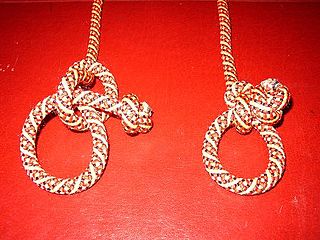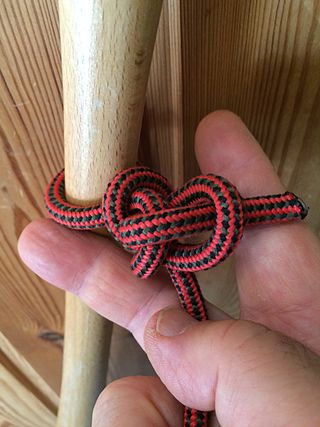
The bowline is an ancient and simple knot used to form a fixed loop at the end of a rope. It has the virtues of being both easy to tie and untie; most notably, it is easy to untie after being subjected to a load. The bowline is sometimes referred to as king of the knots because of its importance. Along with the sheet bend and the clove hitch, the bowline is often considered one of the most essential knots.

The overhand knot is one of the most fundamental knots, and it forms the basis of many others, including the simple noose, overhand loop, angler's loop, reef knot, fisherman's knot, half hitch, and water knot. The overhand knot is a stopper, especially when used alone, and hence it is very secure, to the point of jamming badly. It should be used if the knot is intended to be permanent. It is often used to prevent the end of a rope from unraveling. An overhand knot becomes a trefoil knot, a true knot in the mathematical sense, by joining the ends. It can also be adjusted, faired, or mis-tied as a half hitch.

The constrictor knot is one of the most effective binding knots. Simple and secure, it is a harsh knot that can be difficult or impossible to untie once tightened. It is made similarly to a clove hitch but with one end passed under the other, forming an overhand knot under a riding turn. The double constrictor knot is an even more robust variation that features two riding turns.

A shank is a type of knot that is used to shorten a rope or take up slack, such as the sheepshank. The sheepshank knot is not stable. It will fall apart under too much load or too little load.

The marlinespike hitch is a temporary knot used to attach a rod to a rope in order to form a handle. This allows more tension than could be produced comfortably by gripping the rope with the hands alone. It is useful when tightening knots and for other purposes in ropework.

The figure-eight knot or figure-of-eight knot is a type of stopper knot. It is very important in both sailing and rock climbing as a method of stopping ropes from running out of retaining devices. Like the overhand knot, which will jam under strain, often requiring the rope to be cut, the figure-eight will also jam, but is usually more easily undone than the overhand knot.
The figure-eight or figure-of-eight knot is also called the Flemish knot. The name figure-of-eight knot appears in Lever's Sheet Anchor; or, a Key to Rigging. The word "of" is nowadays usually omitted. The knot is the sailor's common single-strand stopper knot and is tied in the ends of tackle falls and running rigging, unless the latter is fitted with monkey's tails. It is used about ship wherever a temporary stopper knot is required. The figure-eight is much easier to untie than the overhand, it does not have the same tendency to jam and so injure the fiber, and is larger, stronger, and equally secure.

Figure-eight loop is a type of knot created by a loop on the bight. It is used in climbing and caving.
The Flemish loop or figure-eight loop is perhaps stronger than the loop knot. Neither of these knots is used at sea, as they are hard to untie. In hooking a tackle to any of the loops, if the loop is long enough it is better to arrange the rope as a cat's paw.

The Munter hitch, also known as the Italian hitch, mezzo barcaiolo or the crossing hitch, is a simple adjustable knot, commonly used by climbers, cavers, and rescuers to control friction in a life-lining or belay system. To climbers, this hitch is also known as HMS, the abbreviation for the German term Halbmastwurfsicherung, meaning half clove hitch belay. This technique can be used with a special "pear-shaped" HMS locking carabiner, or any locking carabiner wide enough to take two turns of the rope.

The triple bowline knot is a variation of the bowline knot. The knot can be applied in emergency situations, such as mountain rescue.

The offset overhand bend is a knot used to join two ropes together end-to-end. It is formed by holding two rope ends next to each other and tying an overhand knot in them as if they were a single line. Due to its common use in several fields, this bend has become known by many names, such as thumb knot, openhand knot, one-sided overhand knot or flat overhand bend (FOB), though the terms "one-sided" and "flat" are considered incorrect.

The double overhand knot or barrel knot is simply an extension of the regular overhand knot, made with one additional pass. The result is slightly larger and more difficult to untie. It forms the first part of the surgeon's knot and both sides of a double fisherman's knot. According to The Ashley Book of Knots, "A double overhand knot tied in a cat-o'-nine-tails is termed a blood knot."

A Yosemite bowline is a loop knot often perceived as having better security than a bowline. If the knot is not dressed correctly, it can potentially collapse into a noose, however testing reveals this alternative configuration to be strong and safe as a climbing tie-in.

A honda knot is the loop knot commonly used in a lasso. Its round shape, especially when tied in stiff rope, helps it slide freely along the rope it is tied around. To tie, first place an overhand knot in the end of the rope. Then tie a second overhand knot, pass the running end of the rope through it, and tighten.

The Palomar knot is a knot that is used for securing a fishing line to a fishing lure, snap or swivel.

The falconer's knot is a knot used in falconry to tether a bird of prey to a perch. Some sources show this knot to be identical to the halter hitch, but with a specific method of single-handed tying needed when the other hand is occupied holding the bird.

The strangle knot is a simple binding knot. Similar to the constrictor knot, it also features an overhand knot under a riding turn. A visible difference is that the ends emerge at the outside edges, rather than between the turns as for a constrictor. This knot is a rearranged double overhand knot and makes up each half of the double fisherman's knot.
The strangle knot starts with a round turn and the end is stuck under two parts. It may be used to tie up a roll. It can only be tied around a cylindrical shape. If required, a loop may be stuck instead of the end, which makes a slipped knot that is one of the best for tying up sacks and meal bags. With one or two additional turns the strangle knot makes an excellent temporary whipping for the end of a rope.

A chain sinnet is a method of shortening a rope or other cable while in use or for storage. It is formed by making a series of simple crochet-like stitches in the line. It can also reduce tangling while a rope is being washed in a washing machine.

In knot tying, a bight is a curved section or slack part between the two ends of a rope, string, or yarn. A knot that can be tied using only the bight of a rope, without access to the ends, is described as in the bight. The term "bight" is also used in a more specific way when describing Turk's head knots, indicating how many repetitions of braiding are made in the circuit of a given knot.



















